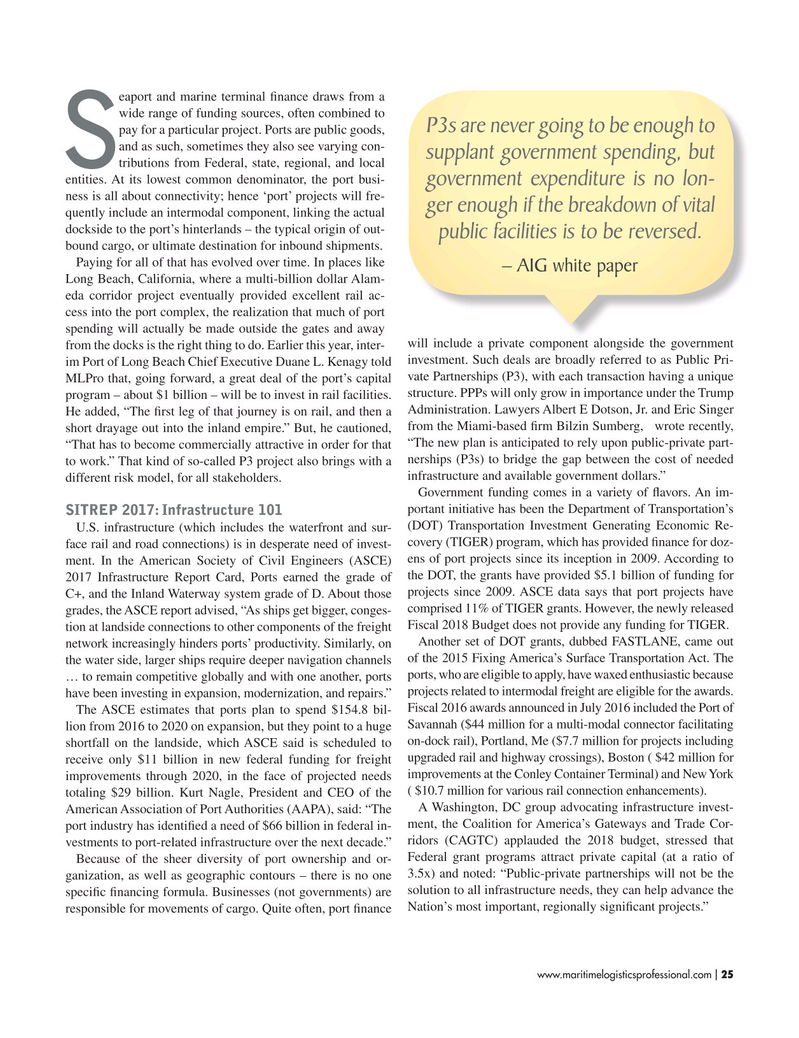
Page 25: of Maritime Logistics Professional Magazine (May/Jun 2017)
BUNKER OPERATIONS & PORTS
Read this page in Pdf, Flash or Html5 edition of May/Jun 2017 Maritime Logistics Professional Magazine
eaport and marine terminal fnance draws from a wide range of funding sources, often combined to
P3s are never going to be enough to pay for a particular project. Ports are public goods, and as such, sometimes they also see varying con- supplant government spending, but
Stributions from Federal, state, regional, and local entities. At its lowest common denominator, the port busi- government expenditure is no lon- ness is all about connectivity; hence ‘port’ projects will fre- ger enough if the breakdown of vital quently include an intermodal component, linking the actual dockside to the port’s hinterlands – the typical origin of out- public facilities is to be reversed.
bound cargo, or ultimate destination for inbound shipments.
Paying for all of that has evolved over time. In places like – AIG white paper
Long Beach, California, where a multi-billion dollar Alam- eda corridor project eventually provided excellent rail ac- cess into the port complex, the realization that much of port spending will actually be made outside the gates and away will include a private component alongside the government from the docks is the right thing to do. Earlier this year, inter- im Port of Long Beach Chief Executive Duane L. Kenagy told investment. Such deals are broadly referred to as Public Pri-
MLPro that, going forward, a great deal of the port’s capital vate Partnerships (P3), with each transaction having a unique program – about $1 billion – will be to invest in rail facilities. structure. PPPs will only grow in importance under the Trump
He added, “The frst leg of that journey is on rail, and then a Administration. Lawyers Albert E Dotson, Jr. and Eric Singer short drayage out into the inland empire.” But, he cautioned, from the Miami-based frm Bilzin Sumberg, wrote recently, “That has to become commercially attractive in order for that “The new plan is anticipated to rely upon public-private part- to work.” That kind of so-called P3 project also brings with a nerships (P3s) to bridge the gap between the cost of needed infrastructure and available government dollars.” different risk model, for all stakeholders.
Government funding comes in a variety of favors. An im- portant initiative has been the Department of Transportation’s
SITREP 2017: Infrastructure 101 (DOT) Transportation Investment Generating Economic Re-
U.S. infrastructure (which includes the waterfront and sur- covery (TIGER) program, which has provided fnance for doz- face rail and road connections) is in desperate need of invest- ment. In the American Society of Civil Engineers (ASCE) ens of port projects since its inception in 2009. According to 2017 Infrastructure Report Card, Ports earned the grade of the DOT, the grants have provided $5.1 billion of funding for
C+, and the Inland Waterway system grade of D. About those projects since 2009. ASCE data says that port projects have comprised 11% of TIGER grants. However, the newly released grades, the ASCE report advised, “As ships get bigger, conges- tion at landside connections to other components of the freight Fiscal 2018 Budget does not provide any funding for TIGER.
Another set of DOT grants, dubbed FASTLANE, came out network increasingly hinders ports’ productivity. Similarly, on the water side, larger ships require deeper navigation channels of the 2015 Fixing America’s Surface Transportation Act. The … to remain competitive globally and with one another, ports ports, who are eligible to apply, have waxed enthusiastic because have been investing in expansion, modernization, and repairs.” projects related to intermodal freight are eligible for the awards.
Fiscal 2016 awards announced in July 2016 included the Port of
The ASCE estimates that ports plan to spend $154.8 bil- lion from 2016 to 2020 on expansion, but they point to a huge Savannah ($44 million for a multi-modal connector facilitating shortfall on the landside, which ASCE said is scheduled to on-dock rail), Portland, Me ($7.7 million for projects including receive only $11 billion in new federal funding for freight upgraded rail and highway crossings), Boston ( $42 million for improvements through 2020, in the face of projected needs improvements at the Conley Container Terminal) and New York totaling $29 billion. Kurt Nagle, President and CEO of the ( $10.7 million for various rail connection enhancements).
A Washington, DC group advocating infrastructure invest-
American Association of Port Authorities (AAPA), said: “The ment, the Coalition for America’s Gateways and Trade Cor- port industry has identifed a need of $66 billion in federal in- vestments to port-related infrastructure over the next decade.” ridors (CAGTC) applauded the 2018 budget, stressed that
Federal grant programs attract private capital (at a ratio of
Because of the sheer diversity of port ownership and or- ganization, as well as geographic contours – there is no one 3.5x) and noted: “Public-private partnerships will not be the specifc fnancing formula. Businesses (not governments) are solution to all infrastructure needs, they can help advance the responsible for movements of cargo. Quite often, port fnance Nation’s most important, regionally signifcant projects.” www.maritimelogisticsprofessional.com 25
I

 24
24

 26
26
